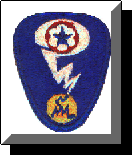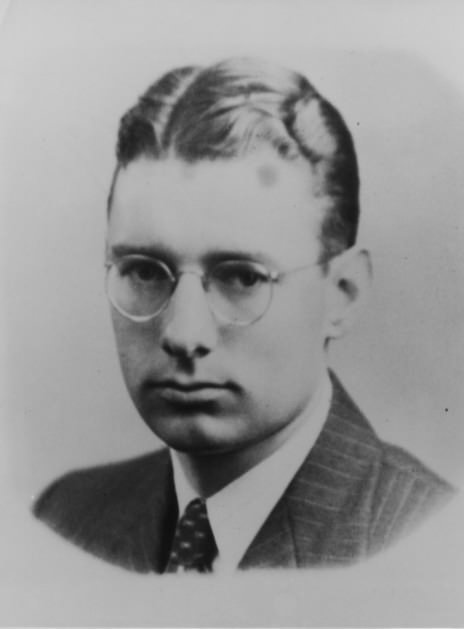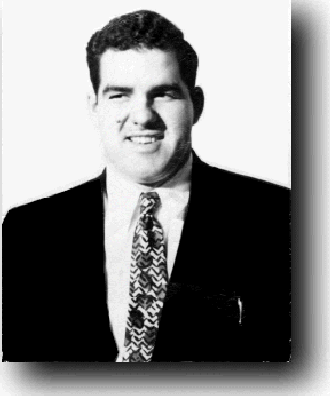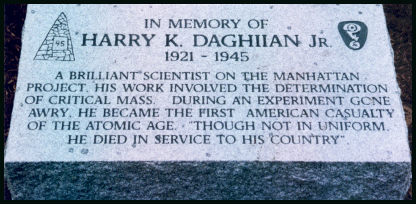
The original patch of the
Manhattan Project Employees 1943
In Memory of...Children of the Manhattan
Project of the Manhattan
Project
Peter Newport
Bragg Jr.
Harry K. Daghlian
Louis P. Slotin
Douglas Paul Meigs

Yucca Mountain Nuclear Repository
Protest: Also Earthquake Skull Mountain Nevada 14 June
2002

Peter Newport Bragg 1920 -
1944
A brilliant
chemical engineer, he volunteered for a dangerous
assignment while employed by the U. S. Navy
Research Laboratory's "pilot-plant" at
the Philadelphia Navy Yard. As part of the
super-secret Manhattan Project, it was the Lab's
mission to perfect the thermal diffusion process
for the enrichment of uranium. On Sept. 2,
1944, while working to unclog a tube in a complex
array of pipes, Peter was killedin a horrific
explosion that sent a cloud of radioactive
uranium hexafluoride over much of the Navy Yard
including the battleship USS Wisconsin, berthed
just 200 yards away. A fellow co-worker,
Douglas Meigs, was also killed. His work
was crucial to the development of the first
atomic bomb, and in his own way, his contribution
helped bring about an early end to World War
II. Although not in uniform, he died in
service to his country.
|
|
Harry K. Daghlian Biography 
 Born in Waterbury, CT
in 1921, Harry K. Daghlian, Jr, was the first child of Harry
(Haroutune) Krikor Daghlian and Margaret Rose Daghlian (n�e
Currie). Soon thereafter, the Daghlian family moved to the
small coastal community of New London, where young Harry
received all of his primary and secondary school education,
while his father worked as an X-ray technician and later
became supervisor of the X-ray laboratory at the Lawrence and
Memorial Hospital.
Born in Waterbury, CT
in 1921, Harry K. Daghlian, Jr, was the first child of Harry
(Haroutune) Krikor Daghlian and Margaret Rose Daghlian (n�e
Currie). Soon thereafter, the Daghlian family moved to the
small coastal community of New London, where young Harry
received all of his primary and secondary school education,
while his father worked as an X-ray technician and later
became supervisor of the X-ray laboratory at the Lawrence and
Memorial Hospital.
As a student
at Harbor Elementary School, the young Harry Daghlian played
the violin in the school orchestra and seemed to be
interested in everything at an early age, winning a silver
cup as the most outstanding student at Harbor. Undoubtedly,
his penchant for mathematics and science was engendered and
fostered by his parents and his uncle, Dr. Garabed K.
Daghlian, who was a professor of physics and astronomy at
Connecticut College (CC) located on the outskirts of New
London. Dr. Daghlian became known as the "father"
of the Physics and Astronomy Department at CC and he was a
frequent speaker for local civic groups on a variety of
subjects ranging from the economic depression of that time to
celestial comets.

In 1938,
Daghlian graduated first in his class in mathematics from
Bulkeley High School and started his undergraduate studies at
MIT at the age of 17. After two years, however, his
fascination with physics, particularly in the emerging field
of particle physics, led him to transfer to the Lafayette,
Indiana campus of Purdue University. There, he obtained a
Bachelor of Science degree in the spring of 1942 and started
his graduate fellowship studies, which included a stint as a
physics instructor.
Nineteen
forty three would prove to be a pivotal year for five Purdue
physicists and their families. In the spring of that year,
Oppenheimer was busily recruiting scientific personnel for
Los Alamos and the majority of early recruits consisted of
scientists with whom he had previous or ongoing
collaborations. It was in this context that Marshall Holloway
was invited to give a lecture at Los Alamos in the spring of
1943, and Oppenheimer used that occasion to recruit
Holloway's group from Purdue. On returning, Holloway
announced his intentions to transfer to Los Alamos after
completion of cross-section studies of tritium and deuterium
(T-D cross-sections). In addition to Holloway, his group
consisted of three senior-level investigators - Charles
"Charlie" P. Baker, Lionel Daniel Percival
"Perc" King and Raemer E. Schreiber. A young
graduate student, Harry K. Daghlian Jr., would help in
finalizing the Purdue studies, and would join them in Los
Alamos at a later date.
Douglas Paul Meigs
and Louis P. Slotin Memorials and Links
 Douglas
Paul Meigs Memorial
Douglas
Paul Meigs Memorial 
 Louis P. Slotin Memorial
Louis P. Slotin Memorial

Madeline Felkins
Rocketdyne/Boeing Hotsheets News
 of the Manhattan
Project
of the Manhattan
Project![]()


 Born in Waterbury, CT
in 1921, Harry K. Daghlian, Jr, was the first child of Harry
(Haroutune) Krikor Daghlian and Margaret Rose Daghlian (n�e
Currie). Soon thereafter, the Daghlian family moved to the
small coastal community of New London, where young Harry
received all of his primary and secondary school education,
while his father worked as an X-ray technician and later
became supervisor of the X-ray laboratory at the Lawrence and
Memorial Hospital.
Born in Waterbury, CT
in 1921, Harry K. Daghlian, Jr, was the first child of Harry
(Haroutune) Krikor Daghlian and Margaret Rose Daghlian (n�e
Currie). Soon thereafter, the Daghlian family moved to the
small coastal community of New London, where young Harry
received all of his primary and secondary school education,
while his father worked as an X-ray technician and later
became supervisor of the X-ray laboratory at the Lawrence and
Memorial Hospital. 


